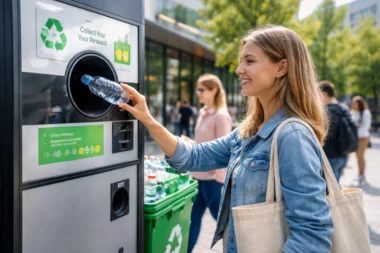Introduction
The growing waste management challenge The increasing population and consumption patterns have led to a significant surge in waste generation worldwide. Improper waste management practices, such as landfilling, pose serious environmental and health risks. The pressing need to address this challenge has brought waste management to the forefront of sustainability discussions.
Waste-to-Energy as a Sustainable Solution Waste-to-energy (WtE) technology offers a promising and sustainable solution to the waste management crisis. By converting waste materials into usable energy, WtE mitigates the burden on landfills, reduces greenhouse gas emissions, and contributes to the circular economy model. Understanding the intricacies of waste-to-energy technology is crucial for adopting this environmentally responsible approach.
Waste-to-Energy Technology Overview
Definition and Objectives Waste-to-energy technology refers to converting various waste materials into energy, typically heat or electricity. The primary objectives of waste-to-energy include waste reduction, resource recovery, and sustainable energy generation.
Types of Waste-to-Energy Technologies There are several waste-to-energy technologies, each with unique conversion mechanisms and applications. The leading technologies include:
Incineration involves the controlled combustion of waste at high temperatures. It converts the organic materials in the trash into heat, which is then used to generate steam and produce electricity.
Gasification is a thermochemical process that converts carbonaceous waste into syngas (a mixture of carbon monoxide, hydrogen, and other gases). The syngas can be used for electricity generation, heat production, or as a feedstock for producing biofuels and chemicals.
Anaerobic Digestion Anaerobic digestion is a biological process that breaks down organic waste without oxygen. It produces biogas, primarily composed of methane, which can be used as a renewable energy source.
Pyrolysis involves the thermal decomposition of waste in the absence of oxygen. It produces biochar, oil, and gas, which can be utilized for various energy applications.
Incineration: Waste-to-Energy Conversion Process
Waste feedstock preparation Before incineration, waste undergoes a series of preparation steps, including sorting, segregation, and shredding. Non-combustible materials and hazardous substances are removed to ensure the waste stream’s suitability for incineration.
Combustion Process The waste is fed into a combustion chamber, where it is subjected to high temperatures, typically ranging from 800 to 1,200 degrees Celsius. The combustion process involves the following:
Combustion Chamber The combustion chamber provides a controlled environment where the waste is exposed to high temperatures. This facilitates the breakdown of organic matter and the release of heat.
Heat Recovery The heat generated during combustion is recovered through heat exchangers. The heat is transferred to a water-based medium, producing steam that drives turbines to generate electricity.
Air Pollution Control Systems Advanced air pollution control systems, such as electrostatic precipitators and scrubbers, are employed to minimize the release of pollutants. These systems capture particulate matter, sulfur dioxide, nitrogen oxides, and other harmful emissions.
Energy Generation and Utilisation The electricity generated from the steam-driven turbines is typically supplied to the power grid for consumption. Some facilities also utilize combined heat and power (CHP) systems, where the excess heat generated is used for district heating or industrial processes.
Residue Management The incineration process produces two types of residues: bottom ash and fly ash. Fly ash is the lighter ash that air pollution control systems collect, while bottom ash is the heavier residue that settles at the bottom of the combustion chamber. These residues undergo treatment and proper disposal, such as stabilization, landfilling, or recycling.
Environmental Considerations Incineration facilities have advanced emission control technologies to minimize environmental impacts. Continuous emission monitoring systems, strict regulatory compliance, and comprehensive ash management practices ensure that the incineration process has minimal adverse effects on air quality and surrounding ecosystems.
Gasification: A Waste-to-Energy Conversion Process
Waste sorting and pre-treatment Similar to incineration, waste intended for gasification undergoes sorting and pre-treatment processes to remove contaminants and optimize the waste stream.
Gasification Reactor In the gasification process, waste is introduced into a gasification reactor, where it undergoes high-temperature conversion in the presence of a limited oxygen supply. The gasification process involves the following:
Syngas Production Under high temperatures, the carbonaceous materials in the waste undergo thermochemical reactions, resulting in the production of syngas. Syngas comprises carbon monoxide, hydrogen, methane, and other combustible gases.
Gas Cleanup: The syngas are cleaned and conditioned through various processes, such as gas cooling, tar removal, and particulate filtration. These steps ensure that impurities are removed, improving the quality and usability of the syngas.
Energy Generation and Utilisation syngas, containing valuable combustible gases, are utilized for energy generation. It can be combusted in a gas turbine or used as fuel for internal combustion engines to produce electricity and heat.
Residue Management Gasification produces solid residues, including slag and ash, which require proper treatment and disposal. These residues can be stabilized, recycled, or disposed of following regulatory guidelines.
Environmental Considerations Gasification technology offers ecological benefits compared to traditional incineration processes. However, gasification plants must implement proper gas cleanup systems to control emissions of pollutants and ensure compliance with environmental regulations.
Advantages and Challenges
Advantages of Waste-to-Energy Technology
- Reduction of landfill space requirements
- Mitigation of greenhouse gas emissions
- Generation of renewable energy
- Potential revenue generation through electricity sales
- Diversion of waste from unsustainable disposal methods
Environmental Concerns and Mitigation Measures Addressing environmental concerns related to waste-to-energy technology is crucial. Measures such as stringent emission control systems, continuous monitoring, and proper residue management help minimize the environmental impact and ensure regulation compliance.
Economic viability and market potential The economic viability of waste-to-energy projects depends on factors such as waste availability, energy prices, and policy support. Waste-to-energy technologies offer market potential, providing economic benefits to project developers and communities.
Regulatory and social acceptance challenges Implementing waste-to-energy projects requires navigating regulatory frameworks and addressing public concerns. Engaging stakeholders, conducting comprehensive environmental impact assessments, and communicating transparently are crucial to achieving social acceptance.
Case Studies: Successful Waste-to-Energy Implementations
Case Study A: Incineration Plant with Combined Heat and Power (CHP) This case study highlights an incineration facility incorporating a combined heat and power system. It demonstrates the efficient utilization of waste heat for district heating, maximizing the plant’s energy output and overall efficiency.
Case Study B: Gasification Facility for Biomass Waste This study focuses on a gasification facility that processes biomass waste. It showcases the utilization of renewable feedstock and the production of clean syngas for electricity generation, contributing to a greener energy mix.
Lessons Learned and best practices Analysing successful waste-to-energy implementations provides valuable insights into lessons learned and best practices. These include effective waste management strategies, stakeholder engagement, and technological optimization for improved performance.
Step-by-Step Guide: Waste-to-Energy Conversion
Waste preparation and handling The first step involves proper waste segregation, sorting, and pre-treatment to ensure a suitable waste stream for the chosen waste-to-energy technology.
Conversion Process (Incineration or Gasification) Depending on the waste characteristics and project objectives, selecting the appropriate waste-to-energy technology is crucial. This step involves understanding the technology’s requirements, sizing the plant, and securing the necessary permits and approvals.
Energy Generation and Recovery The energy generation and recovery phase encompasses the combustion or gasification process, heat recovery mechanisms, and energy utilization for electricity and heat production.
Residue Management and Disposal Residue management is a critical aspect of waste-to-energy projects. Proper treatment, recycling, and disposal of residues ensure compliance with regulations and minimize environmental impacts.
Future Outlook and Conclusion
Advancements in Waste-to-Energy Technology Continuous research and development efforts are driving advances in waste-to-energy technology. Innovations such as improved gas cleanup systems, integration with renewable energy sources, and enhanced efficiency are shaping the future of this sector.
Emerging Trends and Innovations Emerging trends include:
- Using advanced gasification techniques.
- Exploring new feedstock sources.
- Integrating waste management systems to enhance resource recovery and circular economy practices.
The Role of Waste-to-Energy in a Circular Economy Waste-to-energy technology is pivotal in transitioning to a circular economy, where waste is considered a valuable resource. It enables the efficient utilization of waste materials, reduces reliance on fossil fuels, and promotes resource conservation.
Conclusion:
Harnessing the Potential of Waste-to-Energy Waste-to-energy technology offers a sustainable and efficient solution to the growing waste management challenge. By converting waste into valuable energy, it contributes to environmental protection, reduces greenhouse gas emissions, and promotes the efficient use of resources. Understanding the intricacies of waste-to-energy technology empowers individuals, businesses, and policymakers to harness its potential and drive the shift toward a greener and more sustainable future.



